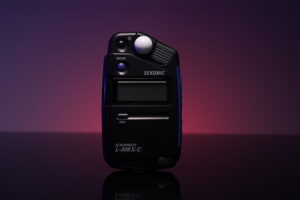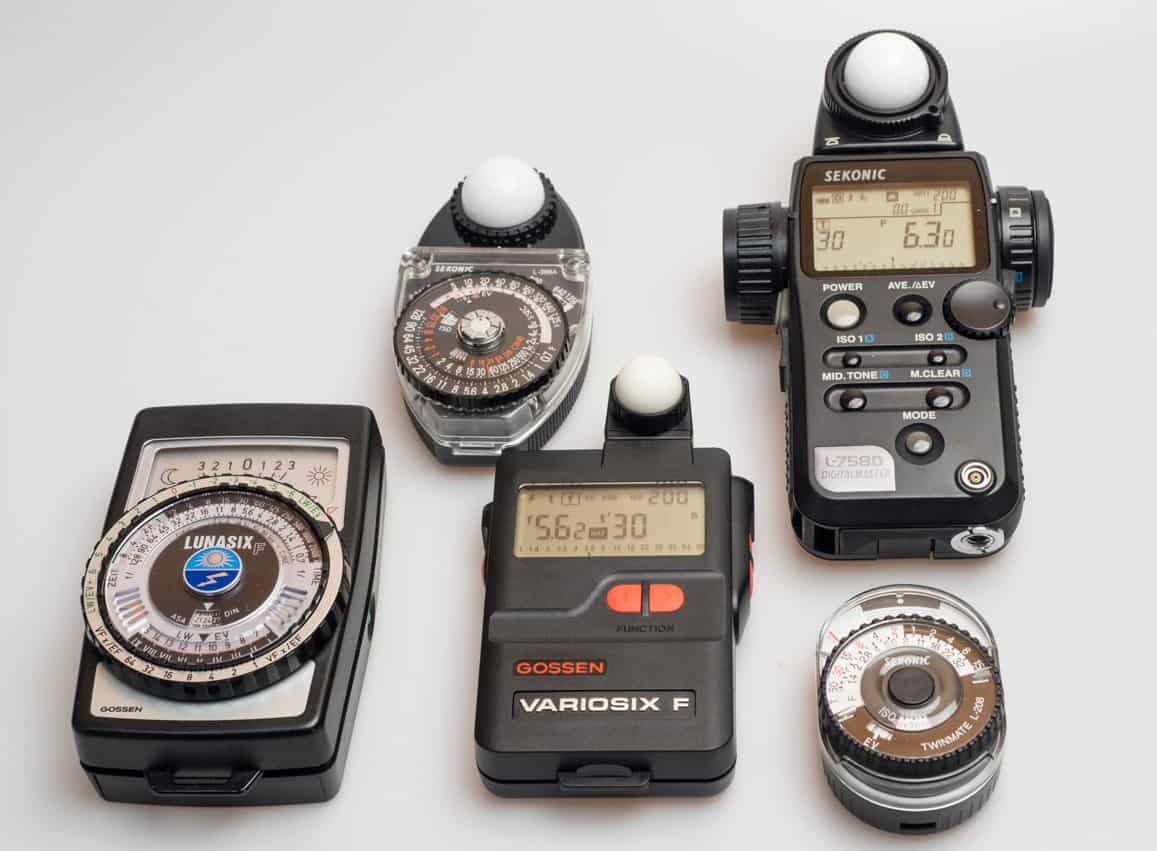Are you confused with the difference between light meters and flash meters in photography?
While both devices serve similar purposes, there are distinct differences between them that are important to understand. In this post, we’ll explore these differences to help you understand their individual roles.
I’ve created a quick info table outlining the fundamental differences between a light meter and a flash meter. Additionally, I’ve included plenty of detailed information in the following sections of the blog. Feel free to read about the nuanced differences between these two gadgets.
| Aspect | Light Meter | Flash Meter |
|---|---|---|
| Measurement Types | Measures ambient light and/or reflected light | Measures ambient light, reflected light, and flash light |
| Use | Suitable for general light measurement | Specifically designed for flash photography |
| Features | Typically includes incident and reflected light measurement modes | Includes incident, reflected, and flash light measurement modes |
| Flash Sync Capability | Does not have built-in flash sync capability | Often includes built-in flash sync capability for measuring flash exposure |
| Flash Duration Measurement | Cannot measure flash duration | Can measure flash duration, helpful for determining flash power and duration |
| Application | Used in various fields such as photography, cinematography, and lighting design | Primarily used in studio photography and professional flash photography |
| Cost | Typically lower cost compared to flash meters | Typically higher cost due to added features and functionality |
Light Meters and Flash Meters
Before diving into the differences between light meters and flash meters, let’s first understand what each device is and how it functions:
Light Meter:
A light meter, also known as an illuminance meter or lux meter, is an essential device for measuring the intensity of ambient light in a particular environment.
This device provides photographers, cinematographers, and other users with accurate exposure assessments by measuring the amount of natural or artificial light within a scene.
Light meters play a crucial role in fine-tuning exposure settings, maintaining consistent lighting environments, and capturing high-quality images or footage.

Whether in photography studios, film sets, architectural design projects, or environmental monitoring activities, these gadgets make it easier to achieve optimal lighting conditions, allowing you to realize your creative visions with precision and consistency.
Indispensable tools for achieving excellence in visual artistry and technical precision, light meters provide objective measurements and guide adjustments for exposure, contrast, and color balance.
Flash Meter:
A flash meter, distinct from its counterpart, the light meter, is a specialized device designed specifically for accurately measuring the light emitted by flash or strobe units.
While a traditional light meter measures ambient light, a flash meter quantifies the output of artificial light sources such as studio strobes, speedlights, and external flash units

Flash meters are used extensively in studio photography, portrait sessions, and other scenarios requiring precise control over artificial lighting setups. They have become a handy tool for photographers seeking impeccable illumination in their compositions.
By providing precise readings of flash intensity, these devices assist photographers in fine-tuning their lighting arrangements, ensuring consistent exposure and achieving desired visual effects.
Whether adjusting lighting ratios, controlling highlights and shadows, or attaining specific levels of brightness and contrast, flash meters play a pivotal role in the pursuit of technical excellence and artistic vision in the realm of artificial lighting photography.
Key Differences Between Light Meters and Flash Meters
Now that you know the basic functions of light meters and flash meters, let’s understand the key differences between the two devices:
Measurement Type:
Light Meter: A light meter is an essential tool for photographers, cinematographers, and professionals in various visual fields.
Its primary function is to measure the intensity of ambient light in a scene, which includes both natural sources like sunlight and artificial light sources like lamps or fluorescent fixtures.
A light meter helps you achieve the best settings for capturing high-quality images or footage by providing precise exposure readings.
It ensures lighting consistency, making it easier to create visually cohesive projects across different environments and lighting situations.
Flash Meter: A flash meter, unlike a light meter, is designed to measure the output of artificial light sources, specifically studio strobes or flash units, when they are triggered.
This device is particularly useful in studio photography, where precise control over artificial lighting is essential for achieving desired results.
By accurately measuring the intensity of flashes, photographers can adjust their equipment settings to ensure consistent exposure and lighting effects.
This level of precision is crucial for producing professional-quality images with balanced lighting and minimal post-processing adjustments.
Usage Scenarios:
Light Meter: The light meter is a versatile tool that can be used in a broad spectrum of lighting conditions, both indoors and outdoors.
It helps to measure the intensity of natural light in outdoor photography, ensuring proper exposure settings for landscapes and portraits.
Indoors, it helps in determining artificial lighting levels in environments like studios or event venues, ensuring consistent and balanced exposure.
Whether under bright sunlight, soft indoor lighting, or challenging mixed lighting conditions, the light meter provides photographers with precise measurements to achieve the best results.
Flash Meter: The flash meter is primarily used in studio photography and controlled lighting environments, and it excels in measuring the output of artificial flash units.
In studio environments, it ensures proper exposure for portraits, product photography, and still-life compositions, allowing photographers to fine-tune lighting setups precisely.
Beyond the studio, it’s ideal for on-location shoots with portable lighting setups, which ensure consistent lighting effects regardless of the environment.
The flash meter focuses on artificial light sources, especially flashes and strobes, allowing photographers to achieve desired lighting ratios, highlights, and shadows, delivering professional-quality results with precision.
Functionality:
Light Meter: The light meter is intended to provide precise readings of ambient light intensity, allowing photographers to adjust key camera settings such as aperture, shutter speed, and ISO.
By analyzing the ambient light levels in a scene, photographers can make informed decisions to achieve optimal exposure and desired creative effects.
Whether capturing landscapes bathed in natural sunlight, portraits in softly lit interiors, or dynamic street scenes under various lighting conditions, the light meter allows you to maintain consistent exposures and capture stunning images with precision.
Flash Meter: In contrast, the flash meter specializes in measuring the output of flash units, assisting photographers in determining the appropriate flash power settings for achieving desired lighting effects.
Photographers can fine-tune their flash power settings to complement ambient light or produce dramatic lighting contrasts by precisely measuring the amount of light that flash units emit.
Whether in studio photography, where controlled lighting setups are essential, or on-location shoots that require portable flash units, the flash meter ensures consistent and precise flash exposures, resulting in professional-quality images with balanced lighting and captivating visual impact.
Features and Controls:
Light Meter: Light meters generally come equipped with a range of features and controls tailored to meet the diverse needs of photographers and cinematographers.
These may include options for selecting different measurement modes to accommodate various lighting conditions, such as incident or spot metering.
Additionally, they often feature controls for adjusting settings like ISO sensitivity, shutter speed, and aperture to fine-tune exposure settings based on the meter’s readings.
Moreover, light meters typically offer intuitive interfaces for interpreting exposure readings, providing visual or numerical displays to guide users in achieving optimal exposure.
Flash Meter: Light meters typically come equipped with a wide array of features and controls designed to meet the diverse needs of photographers and cinematographers.
These may include options for switching between measurement modes to accommodate different lighting conditions, such as incident or spot metering.
Additionally, they often feature controls for adjusting settings like ISO sensitivity, shutter speed, and aperture to fine-tune exposure settings based on the meter readings.
Furthermore, light meters typically provide intuitive interfaces for interpreting exposure readings, with visual or numerical displays to guide you in achieving optimal exposure.
Applications and Use Cases
Light Meter Applications:
Landscape Photography: Light meters are essential tools for landscape photographers, allowing them to measure ambient light levels and adjust camera settings to capture stunning outdoor scenes with optimal exposure.
Portrait Photography: In portrait photography, achieving flattering lighting is critical. Light meters help photographers assess ambient light conditions and create consistent lighting setups for capturing stunning portraits with balanced exposures.
Cinematography: Light meters are essential in cinematography, enabling filmmakers to measure light levels on film sets and adjust lighting setups to achieve desired cinematic effects while maintaining visual consistency throughout a scene or film.
Architecture and Interior Design: Architects and interior designers use light meters to assess natural and artificial lighting levels in spaces, resulting in optimal lighting designs that improve functionality and aesthetics while reducing energy consumption.
Environmental Monitoring: Light meters are used in environmental monitoring applications to measure light pollution levels in urban and natural environments, which helps researchers and policymakers assess the impact of artificial lighting on ecosystems and human health.
Flash Meter Applications:
Studio Photography: Flash meters are essential tools in studio photography, allowing photographers to measure flash output and adjust flash power settings to achieve the desired lighting effects in controlled studio environments.
Product Photography: Product photographers use flash meters to measure flash output and maintain consistent lighting setups in order to capture high-quality images of products with accurate exposures and minimal shadows.
Fashion Photography: Flash meters are essential in fashion photography because they allow photographers to measure flash output and adjust lighting setups to achieve dramatic or subtle lighting effects that complement fashion compositions and highlight details.
Commercial Advertising: In commercial advertising photography, flash meters are used to measure flash output and fine-tune lighting setups to produce impactful images that effectively showcase products or convey brand messages.
Event Photography: Flash meters are useful tools for event photographers, enabling them to measure flash output and adjust lighting setups to capture dynamic moments with optimal exposure and balanced lighting, whether indoors or outdoors.
Conclusion
In summary, while both light meters and flash meters serve similar purposes in aiding exposure control and lighting management, they are designed for different applications and scenarios.
Understanding the differences between these devices is essential for photographers, cinematographers, and lighting professionals looking to achieve the best results in their work.
Whether measuring ambient light in diverse environments or controlling artificial flash output in controlled studio settings, choosing the right tool for the job can significantly impact the quality and consistency of the final images or footage.

